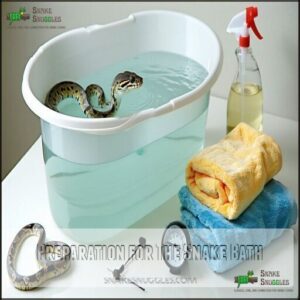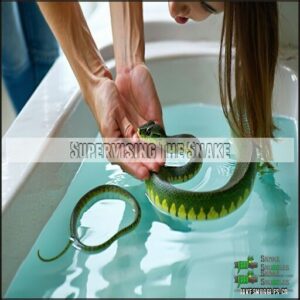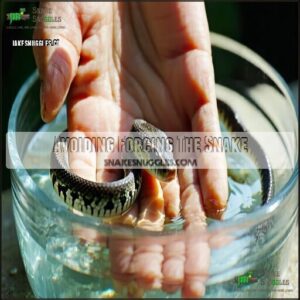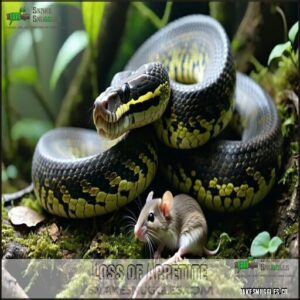This site is supported by our readers. We may earn a commission, at no cost to you, if you purchase through links.
 To bathe a snake, start by filling a clean container with lukewarm water—think baby-bath warm, around 85–90°F.
To bathe a snake, start by filling a clean container with lukewarm water—think baby-bath warm, around 85–90°F.
Make sure the water’s shallow, just deep enough to cover your snake’s body about halfway.
Gently place your snake in the water, letting it soak for 10–15 minutes, and stay nearby to supervise and keep your snake relaxed, because no one likes an unexpected escape.
After the soak, use a soft towel to dry it off completely, especially its belly.
Bathing can help with shedding, constipation, or mites, and remember, snakes bathe for care, not fun—unlike your pet dog, bubble baths aren’t their thing!
Table Of Contents
- Key Takeaways
- Preparation for The Snake Bath
- Bathing Process
- Reasons to Bathe a Snake
- Signs of a Constipated Snake
- Seeking Professional Help
- Frequently Asked Questions (FAQs)
- How do you bathe a snake?
- How to solve the snake problem in the bathhouse?
- Can a snake eat a bath?
- Can a snake swim in a bathtub?
- Is it OK to give a snake a bath?
- How should I soak my snake?
- How often should you bathe a snake?
- Do snakes need to be washed?
- How to give your ball python a bath?
- Can I wash my snake with Dawn?
- Conclusion
Key Takeaways
- Use lukewarm water (80–85°F) in a shallow container, just enough to cover the snake halfway, and never leave it unattended.
- A 10–15 minute soak can help with shedding, constipation, or mites, but don’t force your snake into the water if it resists.
- Dry your snake gently with a soft towel, focusing on tricky areas like the belly, head, and tail to prevent skin issues.
- Regular baths aren’t necessary, but they’re helpful for specific issues like dryness, stuck shed, or maintaining overall cleanliness.
Preparation for The Snake Bath
Before giving your snake a bath, gather everything you’ll need to keep the process safe and stress-free.
Proper preparation ensures a safe, soothing bath experience for your snake while promoting health and relaxation.
From clean, lukewarm water to a proper container and soft towels, a little preparation goes a long way.
Clean Water
Using clean water is essential for a successful snake bath. Avoid tap water with chemicals like chlorine—it can irritate a snake’s delicate skin.
Instead, go for spring or filtered water to guarantee safe snake bath water quality. Consider filtration methods to remove chemical residues or impurities. For ideal water purity, explore options for a reptile water filter.
Regular water changes are also vital to avoid contamination. Test the water if needed to guarantee it’s clean. Keeping snake bath water cleanliness in check supports your pet’s health, making baths both soothing and beneficial.
Suitable Water Temperature
Temperature matters in the context of a relaxing snake bath. Aim for lukewarm water in the ideal range of 80-85°F.
Follow these steps for safe, stress-free fun:
- Use a reptile-safe thermometer to get precise readings.
- Gradually adjust the water temperature—too hot or cold shocks your snake.
- Check for species variation in preferences.
- Monitor water temp throughout to avoid drastic changes.
Ensuring accurate temperature readings requires a reliable reptile thermometer.
Choosing The Container
Choosing the right snake bathing container guarantees a smooth bathing procedure.
Pick a shallow container that’s big enough for your snake to move comfortably, with water kept chest-high. This prevents drowning while letting them soak safely.
A sturdy plastic container works well—easy to clean and unlikely to leak. Look for a shape that offers some space but doesn’t overwhelm smaller snakes.
Lids with ventilation are an extra option if your snake tends to escape. Always prioritize material safety, avoiding anything fragile or harmful.
A well-chosen snake bath container makes bath time safe and stress-free. For the snake’s overall well-being, consider appropriate enclosure size for its primary habitat.
Cleaning The Habitat
Keeping your snake’s habitat clean is just as important as bathing them.
A dirty enclosure can lead to health issues, so regular upkeep is a must. Before the bath, make certain their living space is spotless to complement their hygiene.
Here’s what to focus on:
- Substrate Options: Replace soiled bedding with fresh, safe materials.
- Disinfecting Methods: Use reptile-safe cleaners to sanitize surfaces.
- Humidity Control: Balance humidity to support shedding and hydration.
- Temperature Gradient: Check the hot and cool zones for proper regulation.
Snake enclosure cleaning removes waste, bacteria, and debris, ensuring snake water quality and a clean living environment. A healthy habitat means a happy, thriving snake!
Having Towels Ready
After cleaning the habitat, it’s time to focus on drying your snake properly.
Towels are more than drying tools—they’re part of good snake care.
Look for a soft, absorbent towel, like microfiber or plush cotton, to soak up moisture without irritating their skin.
Dedicated towels for snake bathing maintain hygiene practices are upheld.
Consider purchasing specialized reptile towels for this purpose.
Gently pat your snake dry, focusing on tricky areas like the tail and head.
Avoid rubbing, which can damage delicate scales.
Check absorbency levels to confirm no moisture lingers since damp spots might lead to issues like scale rot.
Store your snake’s towels separately from other laundry—it’s a smart storage solution that avoids spreading germs.
A dry, cozy snake is a happy one!
Bathing Process
Bathing your snake is a straightforward process if you approach it with care and patience.
From placing your snake gently into the water to making sure it stays calm, each step guarantees your pet’s health and comfort.
Placing The Snake in The Water
When starting a snake bath, provide a gentle introduction by slowly lowering your snake into the water.
This gradual submersion helps it adjust while keeping stress levels low. Verify the water depth is shallow enough for its head to remain above water.
Safe handling is key—support your snake’s body to avoid surprises or discomfort.
Throughout, practice snake bathing supervision by monitoring behavior for signs of stress. Patience and care guarantee a safe, stress-free snake bathing experience.
Allowing Soaking Time
Your snake’s soak provides hydration and promotes shedding. Aim for a suitable duration of 10-15 minutes in lukewarm water.
Make certain comfort with these steps:
- Keep water temperature between 80-85°F.
- Water depth should stay chest-high.
- Use a quiet soaking container to minimize stress.
- Time the bath duration accurately.
- Monitor for signs of discomfort.
Supervising The Snake
Snake bathing requires proper supervision to guarantee safety and comfort.
Watch for stress signs like frantic movements or sudden attempts at escape. Keep the bath duration short and adjust if needed.
Maintain water clarity remains clean throughout. Gentle handling lets your snake explore without fear.
Never leave them unattended—your presence helps prevent accidents and guarantees snake stress stays minimal, ensuring proper supervision and gentle handling are key to a safe experience.
Avoiding Forcing The Snake
Forcing your snake into a bath is a surefire way to cause stress and hurt trust.
Instead, focus on a Gentle Introduction and Gradual Acclimation. Follow these steps:
- Let the snake explore the water naturally, offering patience and space.
- Avoid submerging its head—this can trigger unnecessary Snake Stress.
- Watch for Stress Signals, like frantic movements or hissing.
- Respect its boundaries if it resists; never force it to stay.
- Use Positive Reinforcement with calm handling, building trust over time.
A slow, calm approach guarantees safe, effective snake bathing and reduces snake aggression.
Drying The Snake Thoroughly
Once your snake’s bath is over, gently pat it dry with a soft towel. Focus on the tail and head to prevent trapped moisture, which can lead to skin issues.
Thorough drying supports Scale Health and Preventing Blisters. Regular cleaning helps in maintaining a clean habitat.
Use the table below for guidance:
| Step | Action |
|---|---|
| Use soft towel | Pat gently, avoid rubbing |
| Dry head and tail | Check moisture carefully |
| Inspect scales | Confirm no damp spots remain |
| Offer warm hide | Promotes relaxation, Shed Completion |
| Monitor behavior | Prevents stress from Post-Bath Handling |
Drying fully avoids mold, supports healing, and guarantees your snake’s comfort.
Reasons to Bathe a Snake
You’ll need to bathe your snake regularly to help with shedding, treat mite problems, relieve constipation, and keep it clean and healthy.
A warm bath keeps your snake healthy, stress-free, and helps with shedding, mites, constipation, and overall cleanliness.
Your scaly friend doesn’t splash around in puddles in the wild, but a proper bath can prevent many common health issues that plague pet snakes, including mite problems and common health issues.
Promoting Shedding
Many reptile owners discover that baths can be a snake’s best friend during shedding cycles.
When your snake’s skin becomes a stubborn jacket that won’t come off, a warm soak can work wonders for promoting healthy shedding.
Here’s how to help your scaly companion:
- Monitor shedding frequency – Cloudy eyes and dull skin indicate your snake is entering its shed cycle
- Increase humidity levels – A 15-minute bath provides moisture that helps loosen retained shed, especially around eyes and tail tip
- Support proper hydration – Regular soaking prevents dry patches and promotes complete exfoliation of old skin
Relieving Constipation
While helping your snake shed is important, sometimes our scaly friends need a different kind of assistance.
When constipation strikes, a warm bath can be just what the doctor ordered. Lukewarm water (80-85°F) helps relax your snake’s muscles and stimulates bowel movements.
Sign What to Do
Watch for relief during the snake bath – it’s surprisingly effective!
Treating Mite Infestations
Mites can make your snake miserable if left untreated. A proper bath is your first line of defense against these tiny invaders.
Here’s how to tackle a mite infestation:
- Identify the problem – Look for tiny black or red specks moving on your snake’s skin, especially around eyes and heat pits
- Prepare a medicated bath – Use a reptile-safe solution at 80-85°F for 10-15 minutes
- Follow up with enclosure cleaning – Thoroughly disinfect the habitat to prevent reinfestation
Maintaining Cleanliness
Beyond treating mites, regular bathing helps maintain your snake’s cleanliness. A snake bath with clean water prevents infections and keeps scales healthy.
When handling your snake, always wash your hands first to maintain proper handling hygiene. Regular cleaning of both your snake and its enclosure creates a complete snake hygiene routine.
Water quality is vital—use dechlorinated, lukewarm water for best results. After bathing, thoroughly dry your snake to prevent scale rot.
This snake cleaning guide helps guarantee your pet stays healthy between scheduled enclosure sanitation.
Providing Stress Relief
Beyond keeping your snake clean, bath time provides wonderful stress relief for your reptile friend. The warm water creates a soothing environment that helps them relax.
- Safe handling during bath time builds trust between you and your snake
- Gentle introduction to water reduces anxiety about the bathing process
- Positive reinforcement after bathing creates pleasant associations
- Consistent bathing routines help your snake feel secure and comfortable
Always supervise your snake during these calming sessions, watching for signs of relaxation like slower movements and comfortable exploration. This helps in creating a positive environment for your snake.
Signs of a Constipated Snake
You’ll notice your snake is constipated when it shows signs like bloating, unusual lethargy, loss of appetite, or hasn’t pooped in longer than its normal schedule.
A warm bath can help your snake relax its muscles and often encourages a bowel movement, making it one of the first remedies you should try before calling your vet, as it can help with constipation.
Bloating
When your snake’s midsection appears unusually swollen, you’re likely witnessing a telltale sign of constipation. This bloating occurs when your reptile friend can’t pass waste properly, causing uncomfortable distension in their body.
Recognizing snake bloat is essential for prompt intervention. Look for:
- A visible bulge or swelling in the lower third of your snake’s body, often feeling firm to the touch
- Difficulty moving normally, with your snake appearing uncomfortable when handled
- Reduced interest in food or complete refusal to eat until the blockage is resolved
Several factors contribute to snake constipation, including dehydration, improper temperatures in their habitat, or ingesting substrate. For mild cases, a warm bath (80-85°F) can provide effective constipation relief by helping your snake relax and encouraging bowel movements.
Don’t ignore bloating symptoms, as untreated constipation can lead to serious health complications requiring veterinary intervention.
Lethargy
If your snake’s lounging more than usual, it might be dealing with lethargy—a common symptom of constipation or discomfort.
Tired slithering combined with bloating could signal deeper issues needing attention.
Lethargy in snakes often stems from a mix of causes, like dietary imbalance or insufficient hydration.
A snake exhibiting lethargy, along with other symptoms, may be showing sick snake behavior.
Regular monitoring helps catch these problems early.
Make certain proper hydration and observe during a snake bath.
When lethargy persists, consult a snake veterinarian to prevent further health complications.
Loss of Appetite
When your snake turns its nose up at food, constipation might be a hidden culprit.
Snakes don’t just skip meals for no reason.
Consider these:
- Appetite Causes: Sudden changes in food type or feeding routine may lead to disinterest.
- Environmental Factors: Stress from new habitats, frequent handling, or cage changes can disrupt feeding.
- Refusal Reasons: Issues like regurgitation or sluggishness could indicate gut health problems.
If appetite loss persists, visit a snake veterinarian for specialized tips on snake health and proper snake bathing solutions.
Difficulty Defecating
Trouble with defecation could mean your snake is constipated from poor hydration, a low-fiber diet, or lack of exercise.
Warm snake baths, with water at 80-85°F, encourage fecal elimination by relaxing muscles—a simple and effective constipation treatment.
Don’t forget impaction prevention: a high-fiber diet, hydration importance, and probiotics support digestion.
If constipation persists, it’s time for a vet visit for snake constipation relief!
Changes in Behavior
Noticing unusual behavior? A constipated snake’s discomfort can show in stress indicators like restless movements or refusal to soak during snake bathing.
Look for behavioral cues: avoiding handling, aggressive behavior, or odd defensive postures.
- Key sign: Handling changes—if your snake suddenly resists, it could signal discomfort.
Appetite changes and spending less time in its enclosure also point to trouble.
Seeking Professional Help
Sometimes, your snake’s needs might go beyond what you can handle at home.
If you notice severe constipation, persistent mites, or strange symptoms, it’s time to call a reptile expert.
Severe Constipation
If a warm bath doesn’t help with constipation relief, it’s time for veterinary intervention.
Severe snake defecation issues may need professional care, like enemas or hydration methods, to address blockages. Specialists can recommend safe dietary adjustments or explore enema alternatives for stubborn cases.
Ignoring severe constipation might lead to more significant health problems. A change in stool patterns can also be a sign of underlying health issues.
Keep preventative measures in mind, like regular snake bathing and proper hydration, to avoid future issues with your snake’s digestion.
Persistent Mite Infestations
Mites can often be stubborn, so it’s wise to consult a reptile specialist for proper snake mites treatment.
They’ll suggest the best treatment options and help safeguard your snake’s health.
- Thoroughly clean the enclosure to remove lingering parasites.
- Use medicated baths designed for mite treatment under veterinary care.
- Adopt preventative measures, like regular enclosure hygiene.
- Monitor your snake closely for signs of health improvement or lingering issues.
Unusual Symptoms
If your snake shows unusual behavior like lethargy, appetite loss, regurgitation, or behavioral shifts, pay attention.
Signs such as scale abnormalities, lesions/discoloration, respiratory issues, or neurological problems shouldn’t be shrugged off.
These symptoms may point to skin infections, stuck shed, or more serious snake health issues.
Here’s a quick guide:
| Symptom | Possible Cause |
|---|---|
| Snake Lethargy | Stuck Shed, Dehydration |
| Appetite Loss | Constipation, Stress |
| Respiratory Issues | Infection, Poor Humidity |
| Lesions/Discoloration | Infections, Skin Damage |
When something feels off, always consult a reptile specialist promptly.
Acting fast prevents complications and keeps your snake healthy!
Consulting a Reptile Specialist
If your snake’s issues go beyond basic care, it’s time to involve a reptile specialist.
These snake experts handle health challenges that regular remedies can’t fix. A veterinary consultation guarantees your snake gets the specialized care it needs.
Here’s when to consult a professional:
- Persistent Symptoms: If health problems linger after trying home solutions.
- Expert Consultation Needed: For constipation, mites, or unusual behaviors.
- Health Monitoring: A pro provides accurate diagnosis and treatment options.
Save time, stress, and guessing. A vet’s specialized care can make all the difference in your snake’s life. Don’t wait—trust their expertise!
Diagnosing and Treating Abnormalities
When your snake has unusual symptoms, it’s time to go beyond baths and consider health concerns.
Serious snake diseases, like respiratory infections or scale rot, often require a vet’s expertise. Check for signs like loss of appetite or lethargy—they can signal problems such as snake septicemia or mouth rot.
Common issues to address:
- Mite infestation or fungal spores: Persistent pests or skin conditions need parasite control or medicated treatments.
- Prolapses or abnormal swelling: These demand immediate prolapse treatment or advanced care.
- Skin discoloration or retained shed: These can indicate snake skin conditions like scale rot from excess moisture.
Don’t ignore small changes; they can lead to bigger health risks. Be your snake’s health advocate!
Frequently Asked Questions (FAQs)
How do you bathe a snake?
Did you know snake baths can help with shedding and hydration?
Use lukewarm water, fill a shallow container chest-high, and let your snake soak for 10-15 minutes.
Always supervise and dry thoroughly afterward!
How to solve the snake problem in the bathhouse?
Seal off entry points, safely relocate the snake using a broom or hook, and contact professional wildlife control if needed.
Keep calm and avoid direct contact. Humor helps—every spa doesn’t need surprise guests!
Can a snake eat a bath?
A bath isn’t food, so don’t worry.
Snakes can’t eat it.
They might drink some water or explore, but their diet focuses on prey like rodents, not objects or environments like baths.
Can a snake swim in a bathtub?
Absolutely, your snake can swim in a bathtub if the water is shallow and warm—around 80–85°F.
Always supervise closely, keep water at chest level, and make certain it’s chlorine-free to avoid harm.
Is it OK to give a snake a bath?
Soaking serpents can be safe, simple, and smart when done right.
Keep water warm, supervise closely, and never force them.
Baths help with shedding, hydration, and pesky mites. It’s like a spa day!
How should I soak my snake?
Use lukewarm water (80-85°F) in a shallow container, deep enough for the snake’s belly to touch.
Let them soak for 10-15 minutes.
Always supervise, ensuring comfort, and dry them gently afterward.
How often should you bathe a snake?
Think of snake baths like seasonal tune-ups.
Once a month is ideal to prevent mites, aid shedding, and keep skin healthy.
However, only bathe more often if specific issues, like constipation or dryness, arise.
Do snakes need to be washed?
Snakes don’t need regular baths like pets with fur, but occasional bathing helps with shedding, hydration, or parasite removal.
It also keeps them comfortable and clean, especially if they’re struggling with stuck skin or mites.
How to give your ball python a bath?
Imagine your ball python is wearing a jacket too tight to shed.
Gently place them in lukewarm water, chest-deep, for 10-15 minutes.
Dry thoroughly with a soft towel, watching for signs of stress.
Can I wash my snake with Dawn?
You can wash your snake with Dawn, but only in very diluted amounts and under veterinary guidance.
Use regular warm water for routine baths, as soap can irritate the skin and disrupt the snake’s natural oils.
Conclusion
Taking care of your snake doesn’t have to feel like wrestling a slippery rope.
Learning how to bathe a snake is simple and helps with shedding, constipation, and overall health.
Just use lukewarm water, supervise closely, and dry it off completely to avoid issues.
Make baths a part of your snake’s routine when needed, not just for cleanliness but to keep it comfortable and stress-free.
A little care goes a long way for your scaly companion!
- https://www.zillarules.com/articles/how-to-bathe-your-pet-reptile
- https://www.petmd.com/reptile/care/how-bathe-your-reptile
- https://www.reptileforums.co.uk/threads/how-to-bath-a-corn-snake.1254666/
- https://www.cuteness.com/article/bathe-snake/
- https://www.reddit.com/r/ballpython/comments/p3fejs/yay_or_nay_i_filled_my_tub_with_another_1_inch_of/



















